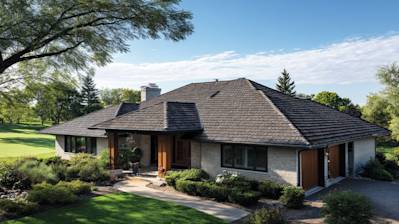From safeguarding your valuables to sheltering you from nature's changes, the roof performs a vital role. Acknowledging the lifespan of your roof, the factors that influence it, and ways to enhance it can aid in maintaining its integrity, thus determining the value of your home investment. If you're keen to learn about "Roof Lifespan", dive into this comprehensive study that leaves no stone unturned.
Understanding the Average Roof Lifespan
One of the frequently asked questions by homeowners embarking on a new construction project or considering a premier Sacramento roof replacement is - "How long should my roof last?" Typically, the lifespan of a standard roof can range between 15 and 30 years. However, various influencing elements such as roofing materials used, climate, quality of installation, and maintenance habits can significantly alter this.
Let's unpack each roofing material, from asphalt shingles to metal roofs, to understand more about their lifespan.
Asphalt Shingles
Asphalt shingles are one of the most widely used materials on residential roofs, offering affordability and a lifespan from 20 to 30 years. Their lifespan can vary based on factors such as climate and maintenance.
Wood Shingles
Wood shingles, famed for their natural aesthetics, manifest an average lifespan of about 25 to 30 years. Remember though, their durability is notably influenced by the climate they're exposed to.
Metal Roofs
Metal roofs are proof that durability and longevity need not always come with a heavy price tag. These roofing styles can comfortably survive for anywhere from 50 to 70 years.
Slate and Tile Roofs
For those unconcerned with the investment, slate and tile roofs offer a remarkable lifespan of about 75 to 100 years. The sturdiness of these material allows them to survive even in harsh climates.
Factors Influencing Roof Lifespan
As previously mentioned, many influencing factors respectively churn out the lifespan of the roof.
- Quality of Installation: Skilled roofing installation can create a significant difference in the longevity of your roof.
- Climate: The weather conditions that your roof routinely faces are a vital determinant of its lifespan.
- Ventilation: A well-ventilated roof can reduce the impact of temperature changes, thus aiding in prolonging the life of the roof.
- Maintenance Habits: Regular inspection and prompt repairs can arrest minor problems from scaling into significant roofing issues.
Effective Ways to Increase Your Roof Lifespan
Once you're equipped with the knowledge of different roofing materials and their lifespan, the next step is to understand how to maintain and extend these timelines. Here are a few key methods:
Regular Inspections
Conduct routine inspections for any signs of damage, especially after significant weather changes. The quicker you spot an issue, the faster it can be resolved, preventing further damage.
Timely Repairs
Roofs with neglected damages tend to wear off sooner. Ensure you take immediate action to repair minor damages once they are noted.
Routine Maintenance
Most homeowners ignore the maintenance aspect until a significant problem surfaces. Preventative maintenance, including cleaning debris and treating moss, can inhibit potential damages.

Frequently Asked Questions about Roof Lifespan
What Factors Affect the Lifespan of a Roof?
Many factors can affect the lifespan of your roof. Elements like the quality of roofing materials, climate and weather conditions, and proper installation play major roles. Other factors, such as regular maintenance, can also extend the lifespan of your roof.
Do Different Types of Roofs Have Different Lifespans?
Yes, different types of roofs have different lifespans. For instance, asphalt shingles, the most common roofing material, tend to last between 15 to 30 years. On the other hand, metal roofs have a longer lifespan, often exceeding 50 years. Wood shingles last around 20-25 years, while slate, copper, and tile roofs can last over 50 years, sometimes even reaching or exceeding a century.
How Can I Extend the Lifespan of My Roof?
Proper and regular maintenance is crucial in extending the lifespan of a roof. It's recommended that homeowners have their roofs inspected at least once a year, ideally in the spring or fall. Other practices like cleaning gutters, removing debris, and checking for damage can also help prolong the lifespan of your roof.
What Are Signs That My Roof's Lifespan is Nearing its End?
Common signs that your roof lifespan is nearing its end include curling or buckling shingles, roof valleys, missing shingles, chimney flashing, shingle granules in the gutters and age of the roof. If you notice any of these signs, it is likely a good time to consider roof replacement or serious repairs.
Can Extreme Weather Shorten My Roof's Lifespan?
Yes, extreme weather can shorten your roof's lifespan. Both hot and cold weather can cause stress to your roof, leading to premature aging and weakening of the material. Furthermore, storms, high winds, and hail can cause immediate and visible damage.
Can I Increase My Roof's Lifespan by Switching Roofing Materials?
Switching to a more durable roofing material could potentially increase your roof's lifespan. For instance, if you switch from asphalt shingles to a metal roof, the lifespan of your roof could potentially double. However, such a change would involve additional costs.
If I Spot a Problem, Should I Replace My Entire Roof?
Not necessarily. The decision to repair versus replace can depend on several factors including the age of the roof, the extent of the damage, and the cost of the repairs. It's best to consult with a roofing professional who can assess the severity of the problem and provide the most practical solution.

Pros of Roof Lifespan
Economic Efficiency
Longer roof lifespans generally mean that homeowners can save money in the long run. The reason is straightforward: the less frequently you are required to replace your roof, the fewer times you have to pay for a costly roof replacement. It’s a simple theory of less work, less cost.
Sustainable
Roofs with longer lifespans are typically more sustainable and environmentally-friendly. When a roof needs to be replaced, the old materials are often disposed of in a landfill. A longer lifespan means less frequent replacements, and therefore, less waste—making roofs with longer lifespans a more eco-friendly choice.
Limited Disruptions
Roofing tasks are often bothersome, causing noise and disrupting everyday activities within the residence and in the surrounding environment. Lengthy roof lifespans diminish the frequency of these disruptions.
Home Value
Longer roof lifespans can have a positive effect on your property's value. If you're thinking about selling your home, a well-maintained roof with considerable remaining lifespan can be an appealing aspect for potential buyers.
Peace of Mind
There’s tremendous value in the peace of mind you gain from knowing your roof—which secures your home from harsh weather conditions—is in good condition and wouldn't necessitate attention or hefty investment anytime soon.
Cons of Roof Lifespan
Higher Initial Cost
Roofs that last longer often come with a higher upfront cost. Materials that are designed for longevity, like metal or slate, are typically more expensive than their shorter-lived counterparts such as asphalt shingles.
Inflexibility
Once installed, a long-lived roof is there to stay—for decades, potentially. This could be considered a drawback for those who enjoy frequently changing the aesthetics of their home, as some roof materials and styles can drastically alter a home's appearance.
Maintenance
Longer roof lifespan doesn’t equate to zero maintenance. In fact, some long-lasting roofs may need specific, regular maintenance to ensure they reach their expected lifespan. Ignoring this can lead to premature aging and subsequent failure of the roof.
Unanticipated Damage
Despite its indicated lifespan, unexpected circumstances can cause damage to any roof type. Extreme weather, falling trees, or accidents could all inflict severe damage requiring costly repair or replacement before the expected end of its lifespan.
Technological Advancements
Choosing a roof for its longevity may mean missing out on technological advancements or efficiency improvements in roofing materials over time. Longer-lasting roofs could hold you back from implementing newer, potentially more effective solutions available in the next decades.
Dependency Factors on Roof Lifespan
Material Type
A significant determining factor in a roof's lifespan is the material used for its construction. For example, asphalt shingle roofs have an expected lifespan of 15 to 20 years, while a metal roof can last anywhere from 40 to 70 years.
Installation
Correct installation of the roof plays a crucial role in its lifetime. Errors or shortcuts during the install process can lead to a shorter lifespan and more frequent necessary repairs.
Climate and Weather
Roofs in areas with harsh weather conditions—extreme heat, heavy snowfall, or regular hail—may not last as long as roofs in milder climates.
Maintenance and Inspection
Regular maintenance and inspections can drastically extend the lifespan of a roof. Identifying and addressing small issues before they turn into major problems can ensure the roof stays in good condition for as long as possible.
Ventilation and Insulation
Proper ventilation and insulation help regulate attic temperatures and moisture levels, preventing a myriad of issues which can decrease a roof's lifespan. Improper ventilation can cause rot, mold, shingle damage, ice dams, and a host of other issues leading to a reduction in roof life.

Myths and Misconceptions About Roof Lifespan
A significant part of home maintenance includes understanding and adjusting our strategies for managing the longevity of our roof. However, people often enter into this process with a series of misconceptions about roof lifespan. Some of these misconceptions might lead to poor decision-making or even unnecessary expenditure. Therefore, debunking these myths is crucial for homeowners.
Myth 1: All Roofs Have the Same Lifespan
The 'One-Size-Fits-All' Fallacy
A popular misconception about roofs is that they all have the same lifespan. This belief holds that regardless of material, climate, or maintenance, all roofs will roughly last the same duration. This is completely false. There are several factors that can affect a roof’s lifespan.
Roofing Material Matters
Different roofing materials have different lifespans. For example, asphalt shingle roofs typically last around 20 years while metal roofs can last up to 50 or 70 years. Some materials like clay or concrete tiles can even last over a century.
Impact of Weather and Climate
Climate and weather conditions also have a significant impact on the lifespan of your roof. Harsh solar exposure, heavy rain, high winds or extreme temperature fluctuation can cause wear and tear on your roof faster than in more moderate climates.
Myth 2: A New Roof Requires No Maintenance
The 'Set It and Forget It' Fallacy
Many believe once a roof is installed, it does not need any additional care. This myth can be harmful as it can lead to neglect, shortening the roof’s lifespan and potentially create costlier problems down the line.
Importance of Regular Inspections
Regular inspections are necessary. These inspections can help spot potential issues like missing shingles, mold growth or loose flashing. Early detection of these problems can prevent them from escalating into major issues.
The Value of Routine Cleaning
Cleaning your roof is also a key part of maintenance. Leaving debris like leaves and branches on your roof can trap moisture, which can lead to leaks or rotten wood.
Myth 3: All Roof Damage is Visible
The 'See It To Believe It' Fallacy
The misconception here is that if the roof looks good from the ground level, it is in good shape. However, not all damage can be seen from ground level, or even upon close up inspection.
Hidden Damages
Issues like small leaks, wear and tear around storm collars of vents or minor hail impacts may not be visible immediately. These can slowly cause major damage over time if not addressed.
Need for Expert Assessment
A professional roofing contractor has the knowledge and experience to detect and assess damage that might be missed by the untrained eye. Without frequent professional inspections, hidden damages can result in expensive repairs or even premature roof replacement.
Myth 4: Insurance Covers All Roof Replacement
The 'Every Damage Covered' Fallacy
Many homeowners believe that any damage to the roof is covered by their home insurance policy. However, insurance companies often have nuanced stipulations about what type of roof damage they cover.
Insurance and Age of Roof
For instance, if your roof is beyond its expected lifespan, the insurance company may only cover the depreciated value rather than the replacement cost.
Insurance and Nature of Damage
It also matters how the roof was damaged. If it is due to a sudden accident or act of nature, it's more likely covered. However, if the damage is due to neglect or poor maintenance, you might find yourself paying out of pocket.
Knowing the right information about rooftop lifespan can save time, money, and effort. It is always good to do research and get professional advice. Hopefully, debunking these common myths about roof lifespan can help homeowners make informed decisions about their roof maintenance. Remember, every roof is unique and so are its needs.
Summary
Roof lifespan can vary based on a number of factors, including materials used, the climate you live in, and how well it's been maintained. Metal roofs tend to last longest, up to 70 years, while asphalt shingle roofs average a lifespan of 15 to 30 years. Regular inspections and maintenance can help catch and repair small issues before they become major problems, extending the life of your roof.
Roof lifespan is an essential consideration when choosing the type of roof to install. You don't want to invest in a roof that will need frequent replacements, which will cost you more in the long run. Always do your research, weigh the pros and cons of different roofing materials, and make the best decision for your home, climate, and budget.
Knowing your roof lifespan can help you plan for the inevitable replacement. It's not a pleasant thought, but roofs don't last forever. If you know the average lifespan of your roof, you can start saving and planning for a replacement when it's near the end of its life. That way, you're not caught off guard by a sudden need for a new roof.
About GVD Renovations
GVD Renovations is a locally-owned, trusted renovation company nestled in the heart of Roseville, CA. For years, we've been transforming houses into dream homes with our exceptional remodeling services. Our team of seasoned professionals specializes in a myriad of renovations including kitchen transformations, bathroom upgrades, siding installations, and window replacements. In GVD Renovations, we commit to exceeding our clients' expectations, turning their creative vision into a tangible reality while ensuring superior quality. Let's rejuvenate your living space together - it's time for your home to shine and reflect the charming Roseville community we all love!
This article is for general information only and not professional advice. Always consult a licensed contractor before making project decisions. Product details, specifications, or warranties may have changed since publication. Brand and product mentions reflect opinion, not endorsements or guarantees.
Tags: Roofing, Home Maintenance, Building Materials,





















